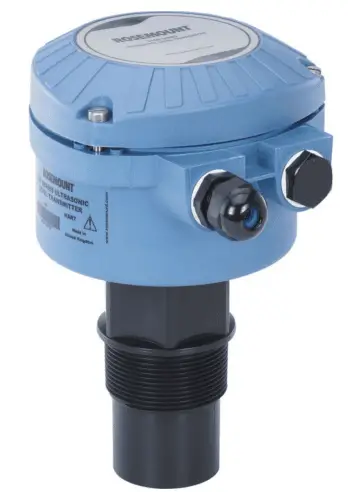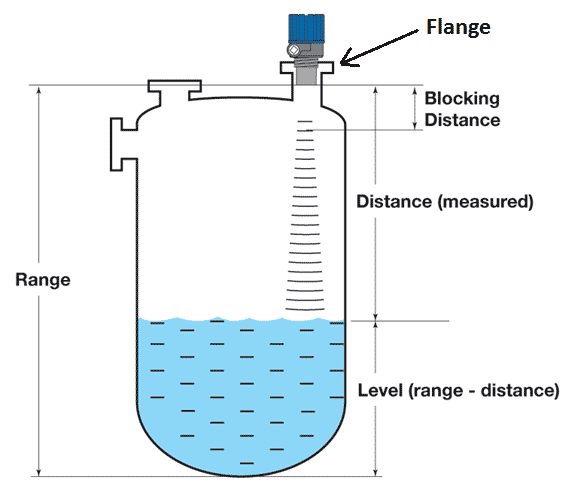The ultrasonic level transmitter also works like a radar-type level transmitter. The ultrasonic level transmitter has its mounting on the top of the tank. It sends sound waves inside the tank or vessel. The transmitter measures the time delay between the transmitted and received echo signal. Then, the transmitter calculates the distance to the liquid surface using the formula.
Working of Ultrasonic Level Transmitter
The below image shows an ultrasonic level transmitter mounted on the top of the tank

The ultrasonic level transmitter is mounted on a flange that has a threaded part. There exist an extended area because transmitter mounting is on a flange. Therefore, some of the areas remain out of their measuring range. In other words, some distance is the blocking distance.
The blocking distance tells the transmitter not to consider the waves coming back from that region. The actual measuring range starts below the blocking distance. Although blocking distance is a part of the range, the true range of measurement does not count blocking distance as a variable. The below figure shows the blocking distance, actual distance, and the level of the liquid.

The ultrasonic level transmitter sends ultrasonic waves into the tank. A piezoelectric transducer creates ultrasonic waves. As soon as waves hit the top of the level, they reflect back. The piezoelectric sensor receives and detects the reflected waves. Now, the total range is already configured in the transmitter.
So by using the distance =(speed X time) formula, the ultrasonic level transmitter calculates the distance. (NOTE: the distance covered by the waves is double i.e. to go and come back to the transmitter. So ultrasonic level transmitter does calculations accordingly)
Now as seen from the above figure,
Range = Distance + Level
Hence, Level = Range – Distance.
Things to keep in mind while using an Ultrasonic level transmitter
- As ultrasonic waves are a kind of mechanical waves or simply sound waves only. They do require a medium for traveling. Hence, we cannot use ultrasonic waves in vacuum services. Because mechanical or sound waves require a medium for traveling and vacuum is not one.
- Temperature can affect the reading. Because as temperature changes, the speed of ultrasonic waves also changes. So, for frequent temperature changing conditions, we do not prefer ultrasonic level transmitters. Also, an ultrasonic transmitter has an inbuilt temperature reading mechanism. This mechanism compensates for the changing temperature’s effect on the wave’s speed.
- The density of the material that we want to measure is also very important. A minimum density difference between the air and the material should be there so that ultrasonic waves can differentiate. If there is less density distance between air and the material, then the ultrasonic level transmitter will always capture the bottom and show 0% reading.
- One important factor for ultrasonic level transmitters is blocking distance. Always keep in mind the blocking distance while installing the ultrasonic level transmitter. Every ultrasonic level transmitter has a defined minimum value of blocking distance. Below that minimum value, we should not set the blocking distance.
- The ultrasonic level transmitter does not work properly with foams and turbulent materials. So, ensure that both conditions are met before selecting and installing an ultrasonic level transmitter. Foams create a layer above the actual level and can cause problems in almost every non-contact type level transmitter. In the case of turbulent material, the level keeps on fluctuating and hence the reading also keeps on fluctuating. You can increase the damping if the turbulence is high. But in critical process applications, increasing the damping is not recommended.
More Points about use of ultrasonic level Transmitter
- Vapor or steam in the tank often affects the readings we get from the ultrasonic level transmitter. So, avoid using an ultrasonic level transmitter for services having vapor or steam. This is because vapor or steam makes condensate droplets on the ultrasonic transmitter’s sensor. The ultrasonic transmitter shows incorrect values when droplets are on the sensor.
- Rosemount 3100 series ultrasonic transmitters have an option of LOST ECHO. Lost Echo occurs when the ultrasonic level transmitter does not receive the echo back. The reason can be a too low level below the selected range or a problem in the ultrasonic sensor. For lost echo conditions, 3 types of output are available. When the transmitter outputs lost echo signal, on local display LE displays. The lost echo time is user settable. We can change the time for which the ultrasonic level transmitter waits before giving an error of lost echo.
- High output: The ultrasonic level transmitter will start sending 21 mA till the lost echo persists.
- Hold output: The ultrasonic level transmitter will start sending the last value till the lost echo persists
- Low output: The ultrasonic level transmitter will start sending 3.6 mA till the lost echo persists.
- The ultrasonic level transmitter’s sensor material is PVDF material. So we should not use it in high temperature (above 60 degrees centigrade) services. This may cause damage to the ultrasonic transmitter’s sensor.
Read Next: